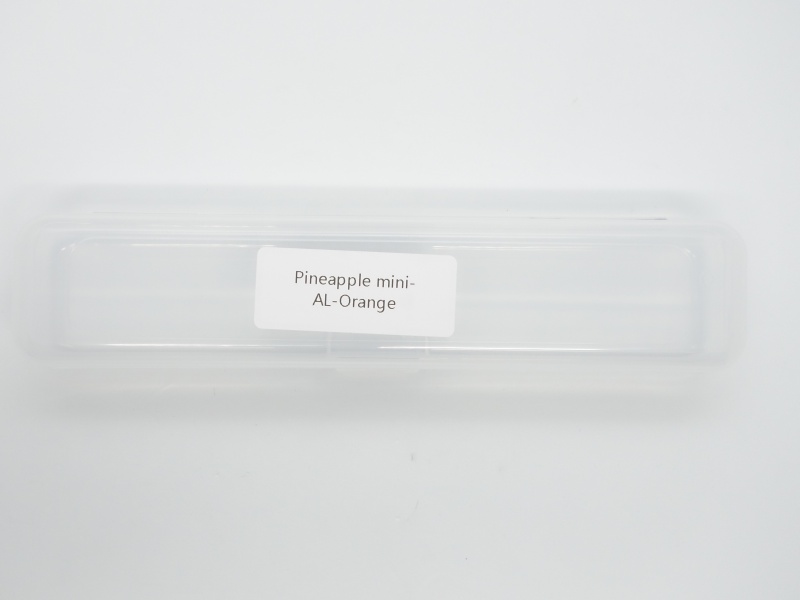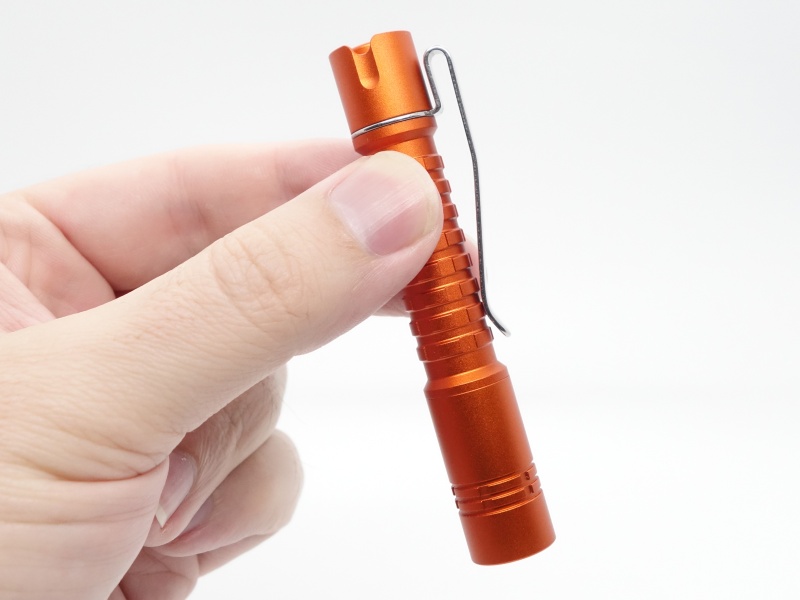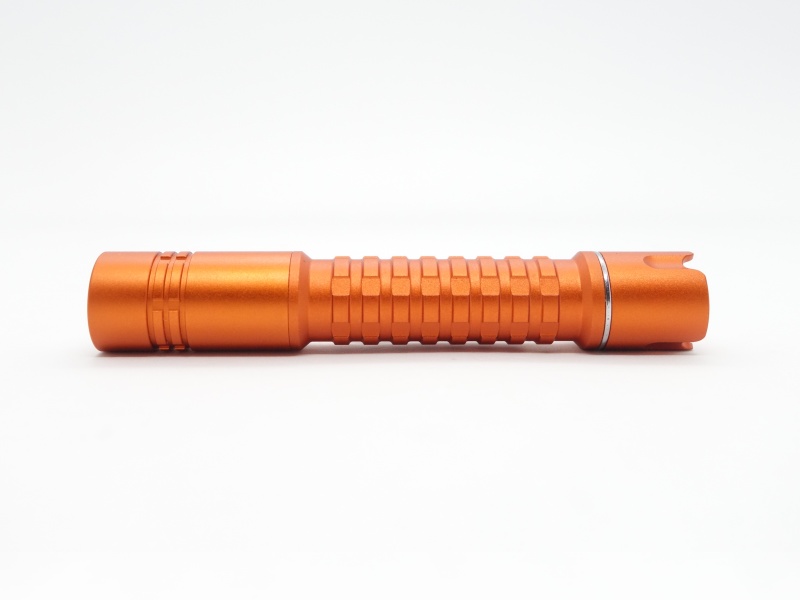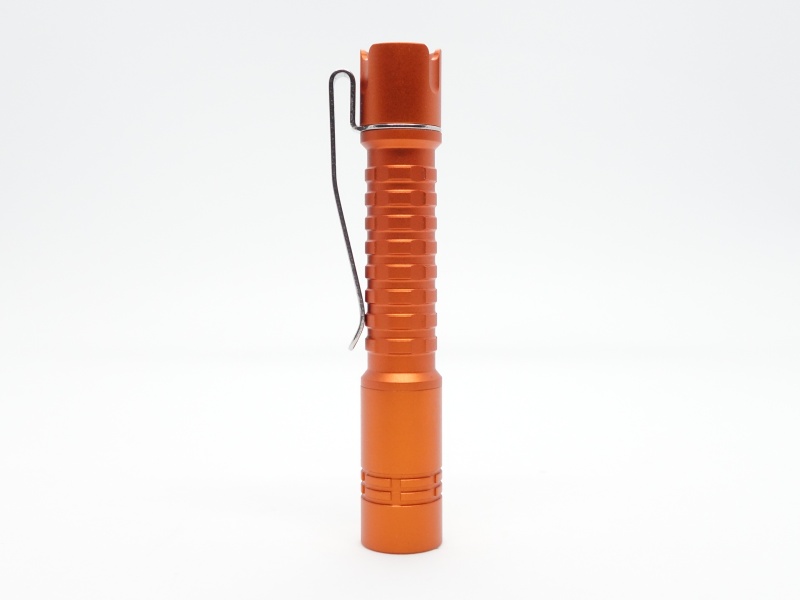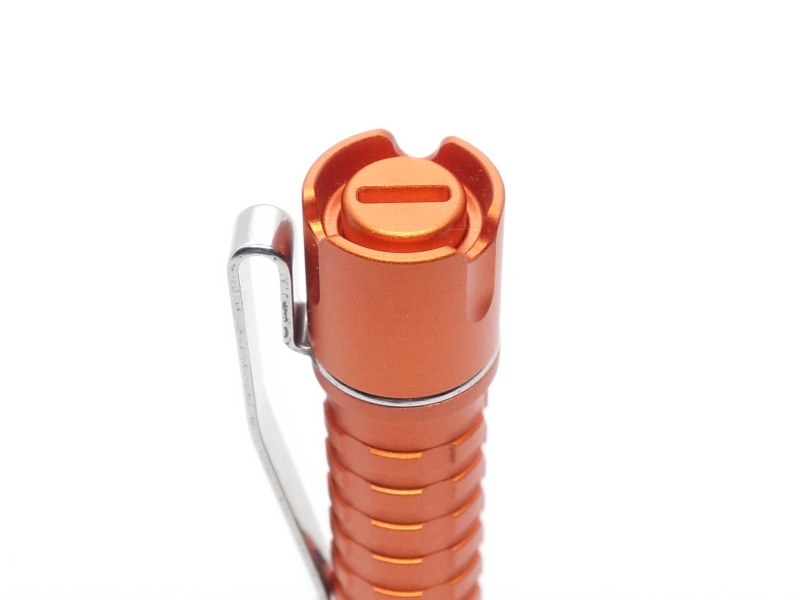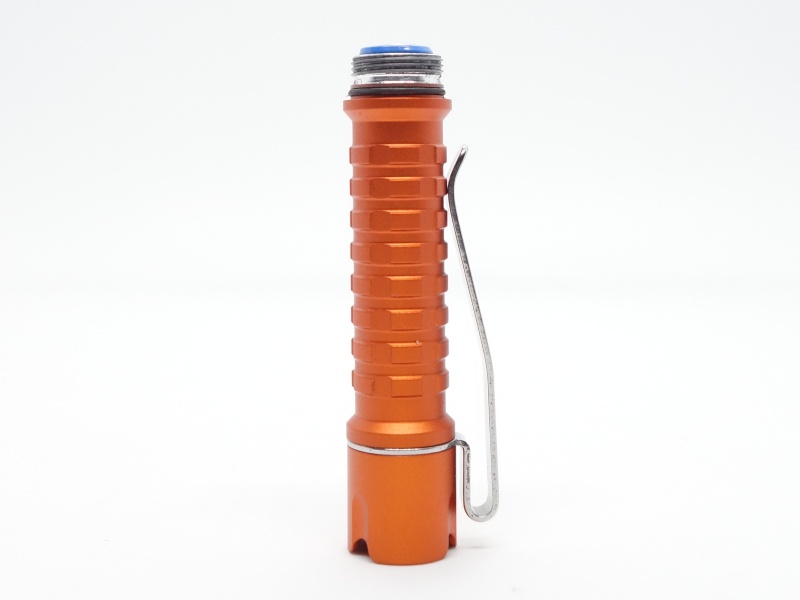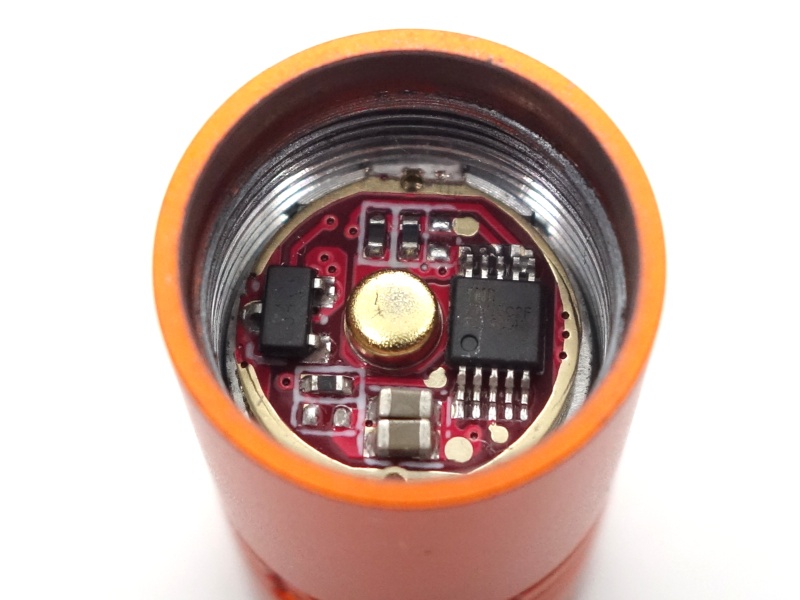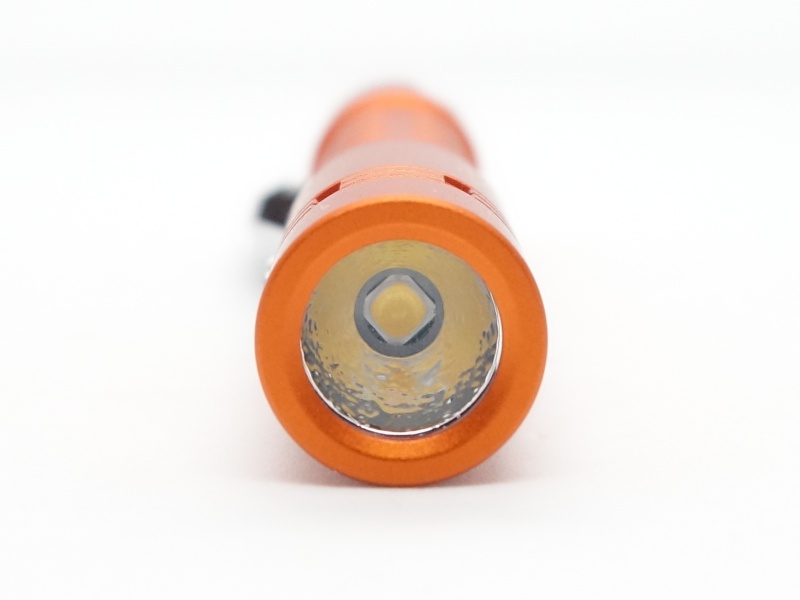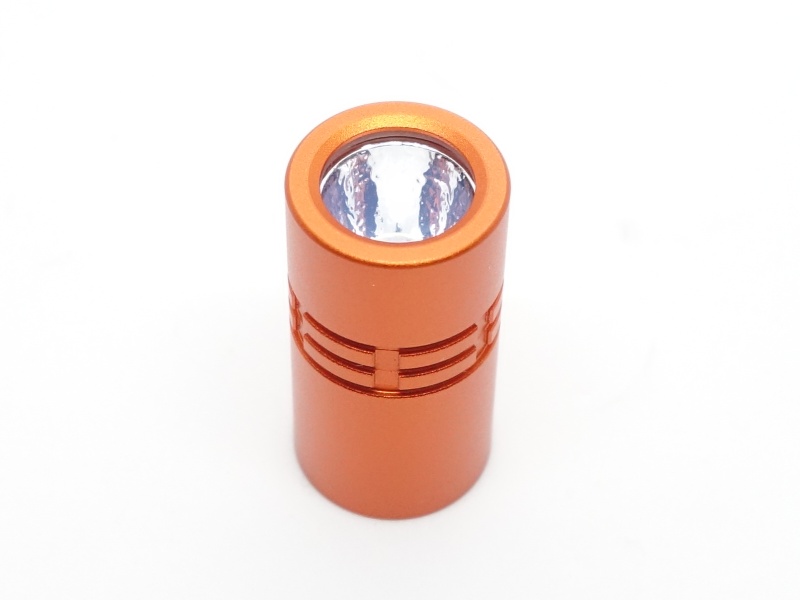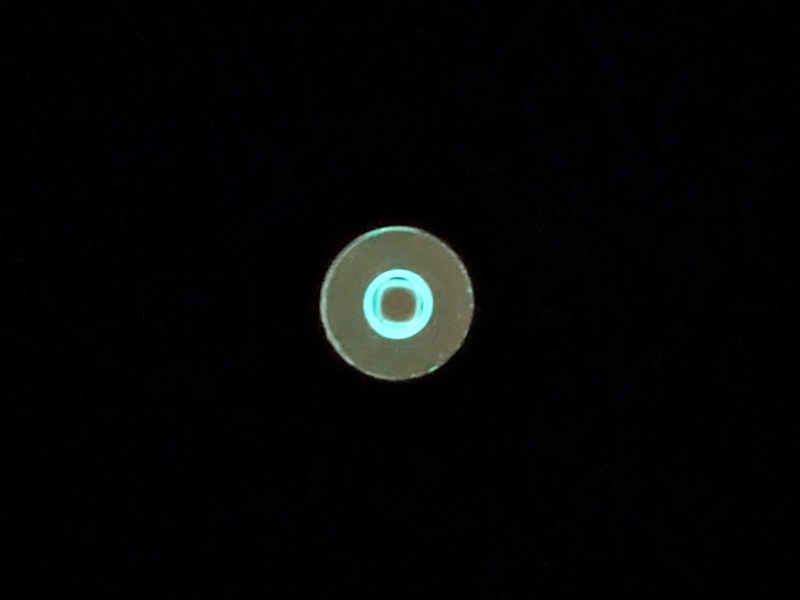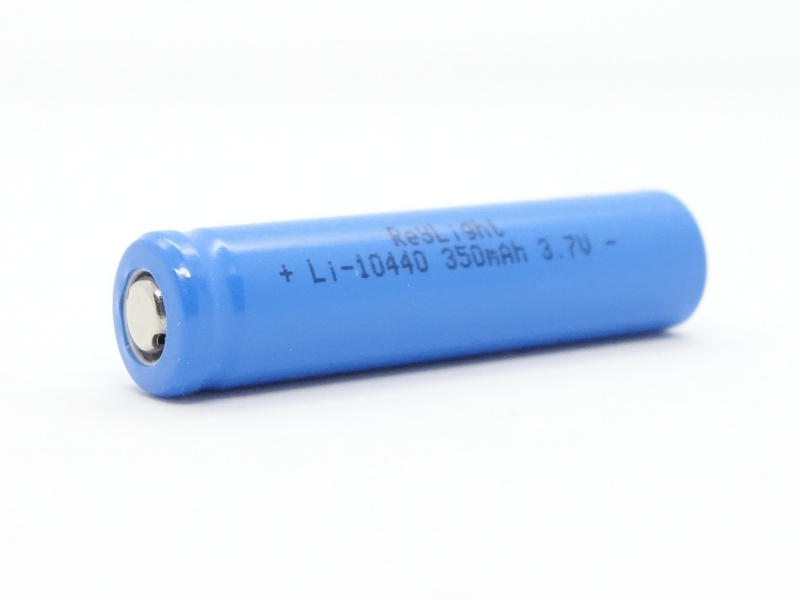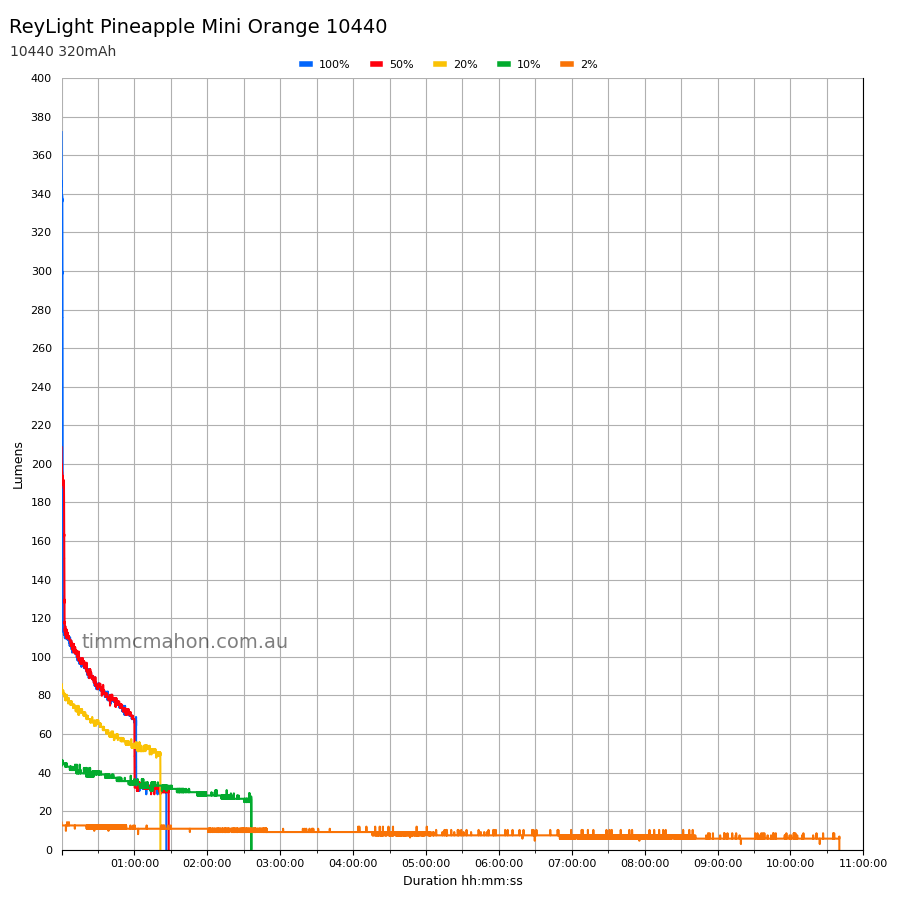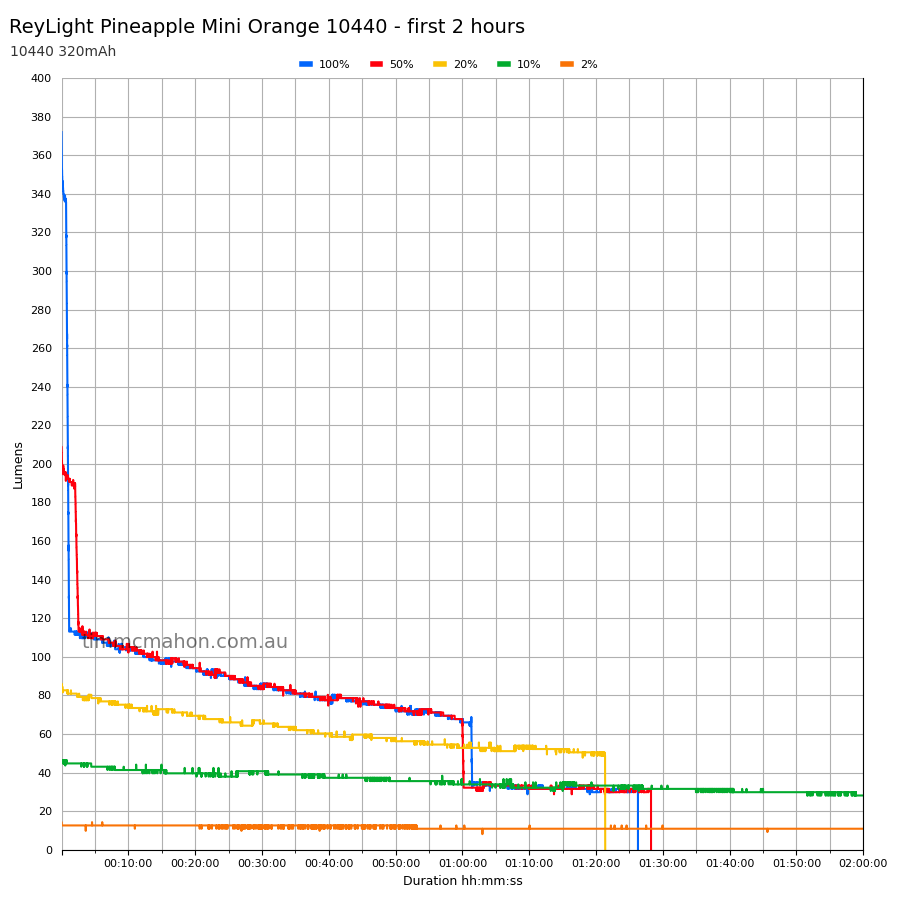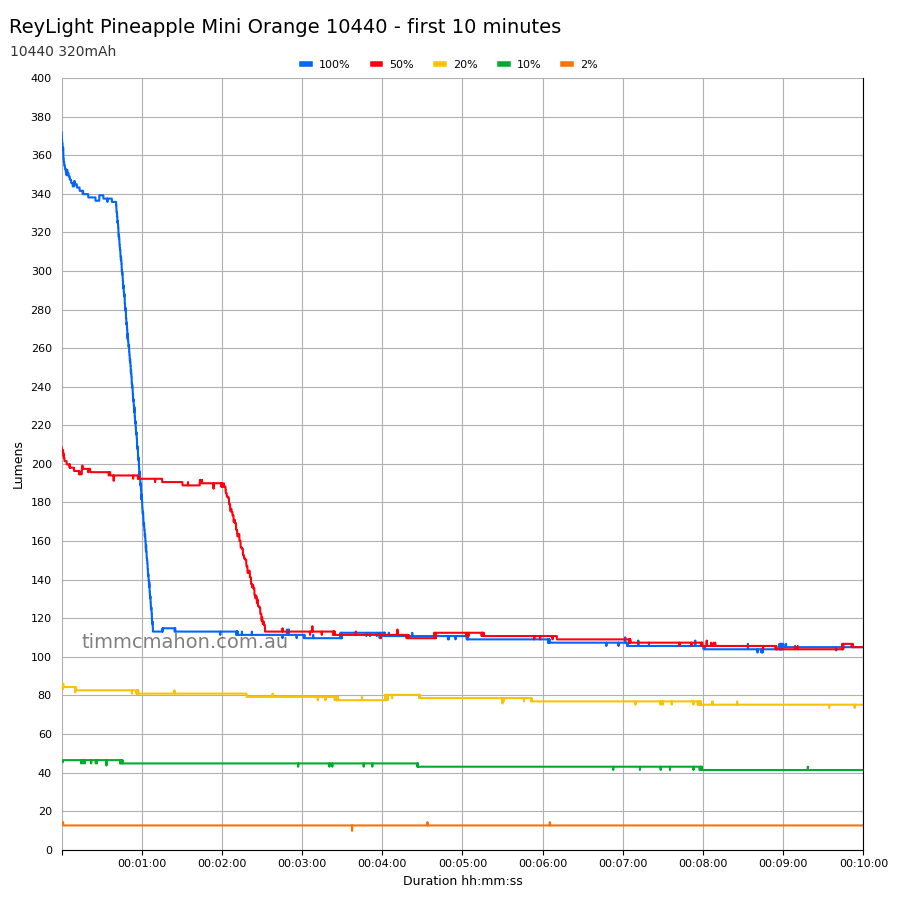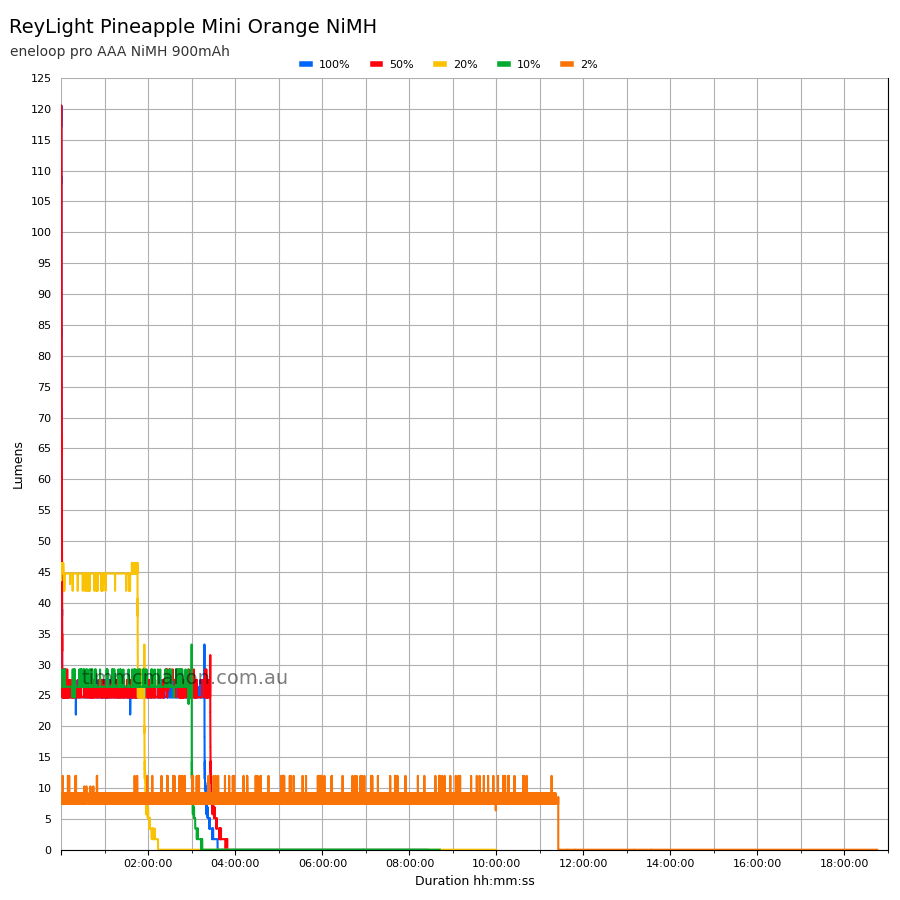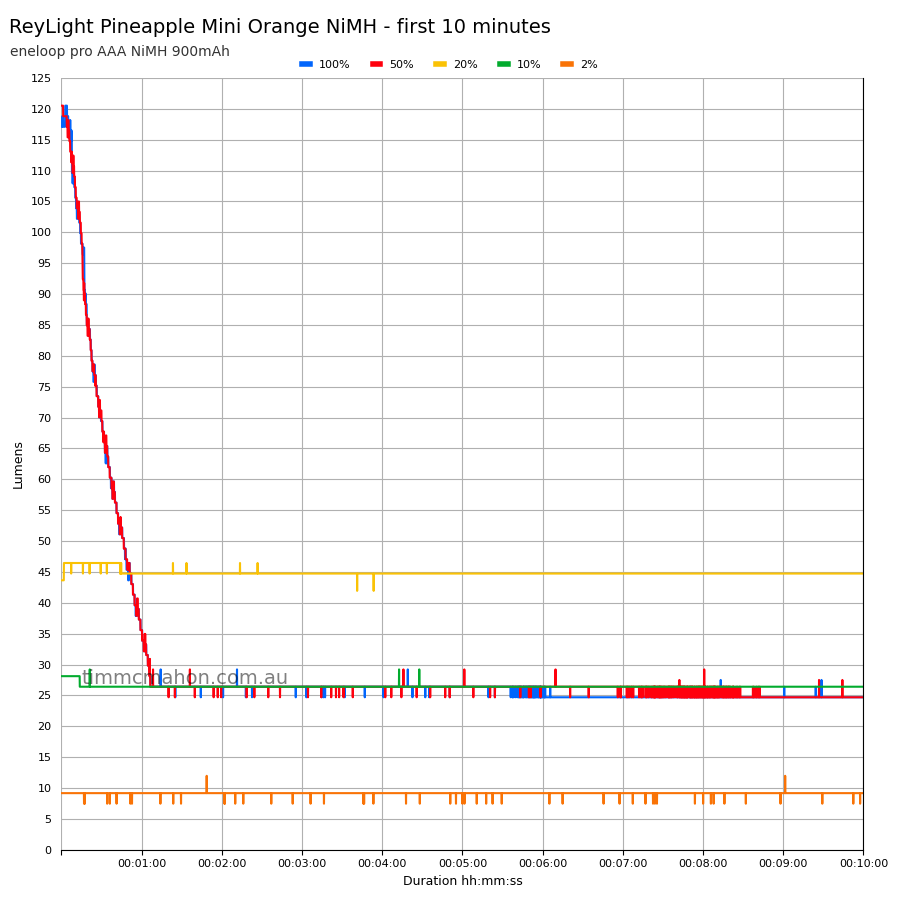ReyLight Pineapple Mini Orange Review
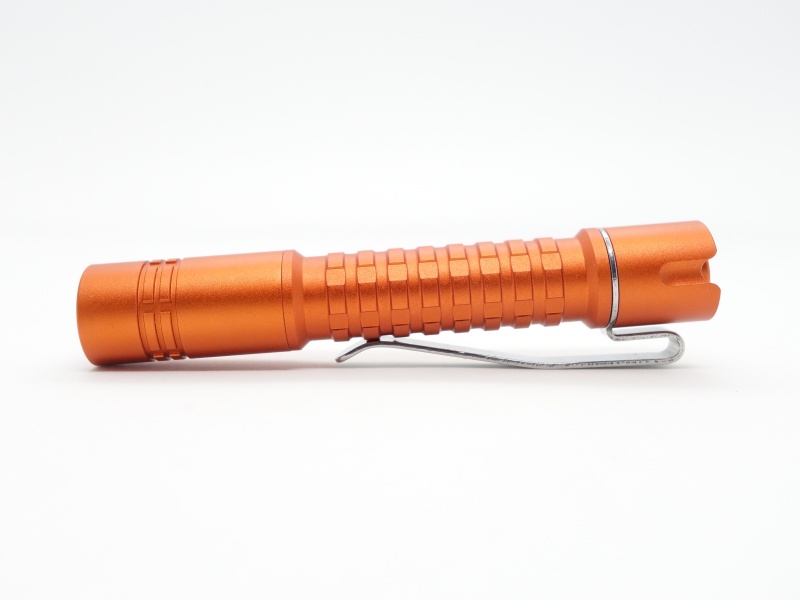
ReyLight Pineapple Mini#
- Specifications
- Introduction
- Torch in use
- Build quality
- LED, bezel, reflector and beam
- Size and comparison
- User interface
- Batteries and charging
- Performance
- Beamshots
- Conclusion
- Price
- Product page
Specifications#
| Brand/model | ReyLight Pineapple Mini |
|---|---|
| LED | Nichia 519A 4000K |
| Maximum lumens | ? lm |
| Maximum beam intensity | ? cd |
| Maximum throw | ? m |
| Battery | 1*10440 Li-ion, 1*AAA Ni-MH |
| Onboard charging | No |
| Material | Aluminium |
| Modes | 4 |
| Blinkies | Strobe, SOS |
| Reflector | OP |
| Review date | February 2024 |
Introduction#
The ReyLight Pineapple Mini is my favourite EDC torch. Today I am reviewing the aluminium version in orange.
The battery, driver and the tailcap have changed since my review of the aluminium version in green:
- The 10440 3.7V Li-ion cell now has a capacity of 350mAh instead of 320mAh.
- The driver has a Fremont Micro Devices (FMD) MCU and it appears to have a slightly better runtime.
- The new tailcap design helps prevent people from accidentally turning the torch on.
I bought this orange version from reylight.net to go with my orange EDC. I have not been paid for this review nor have I held back my opinions of this torch.
Packaging#
The Pineapple Mini came wrapped in foam in a small re-usable transparent box. I keep various electronics and gadgets in my ReyLight boxes.
The following was included in the box:
- ReyLight Pineapple Mini
- Flat top 10440 Li-ion 3.7V 350mAh cell
- Two spare o-rings
- Optional ring (alternative to a pocket clip)
Torch in use#
The ReyLight Pineapple Mini fits perfectly in my hand.
I have been using a Pineapple Mini around the house at night for the past three years. It is my “go to” bedside torch.
If I am going somewhere that does not require a big torch then I will slip a Pineapple Mini into my pocket. Sometimes I end up holding the torch in my mouth in situations where both hands are needed to repair something.
The new tailcap design definitely helps prevent the torch from being accidentally turned on while in my pocket.
The torch can easily tailstand with the new tailcap design.
I am getting used to the new tailcap design. I still prefer the feel of the old tailcap design where the button is easier to press.
Build quality#
This ReyLight Pineapple Mini is made of aluminium and has a matte orange anodised finish. The inside of the tube is also anodised. There are no sharp edges.
The frag design of the tube provides additional grip. There may be other versions of the tube available (ribbed, frag, smooth etc).
The pocket clip feels strong and fits tightly onto my pocket.
The reverse-clicky tailswitch gives a satisfying click.
The threads came lubricated.
The driver has reverse polarity protection, low voltage protection and thermally regulates the output.
Teardown#
Check out my review of the ReyLight Pineapple Mini Green for a teardown.
Video tutorial#
Here is a video tutorial for swapping the emitter in a Pineapple Mini:
ReyLight Pineapple Mini modification for twice the throw!
LED, bezel, reflector and beam#
This particular ReyLight Pineapple Mini comes with a Nichia 519A 4000K emitter and an orange-peel reflector.
There is an anti-reflective coating on the lens.
The centering gasket and the o-ring near the lens glow in the dark.
CCT, CRI, and duv#
I have taken Correlated Colour Temperature (CCT) and Colour Rendering Index (CRI, RA of R1-R8) measurements with the torch positioned a metre away from an Opple Light Master Pro III (G3).
The CCT is around 3946K and the CRI is around 96.
The Delta u, v is close to zero (almost pure white).
The beam produced has a hot spot that smoothly blends into a slightly wider spill. It is suitable for EDC use.
| Cell | Mode | CCT (K) | CRI (Ra) | x | y | Duv |
|---|---|---|---|---|---|---|
| 10440 | 2% | 3902 | 97.1 | 0.3845 | 0.3770 | -0.0010 |
| 10440 | 20% | 3984 | 96.9 | 0.3812 | 0.3763 | -0.0004 |
| 10440 | 100% | 3954 | 96.8 | 0.3818 | 0.3740 | -0.0017 |
Calculate Duv from CIE 1931 xy coordinates
Dimensions and size comparison#
Dimensions#
I took the following measurements using a vernier caliper.
| Measurement | Unit (mm) |
|---|---|
| Torch length | 90.43 |
| Head diameter | 15.00 |
| Tube diameter | 13.50 |
| Tailcap diameter | 15.00 |
| Battery length | 42.7 |
| Battery diameter | 10.0 |
Weight#
I took the following measurements using a digital scale.
| Weight | Unit (g) |
|---|---|
| Torch | 23.91 |
| Battery | 9.09 |
| Torch with battery | 33.00 |
The pocket clip was included in the torch weight.
Size comparison with its competition#
From left to right: ReyLight Pineapple Mini Orange, ReyLight Pineapple Mini Green, ReyLight Pineapple Mini Copper, Olight i3T Brass
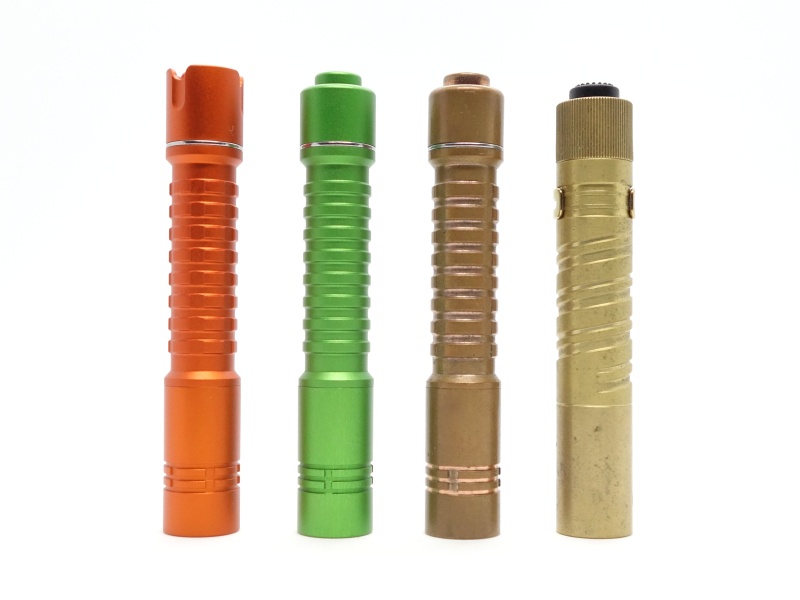
From left to right: ReyLight Pineapple Mini Orange, ReyLight Pineapple Mini Green, ReyLight Pineapple Mini Copper, Olight i3T Brass
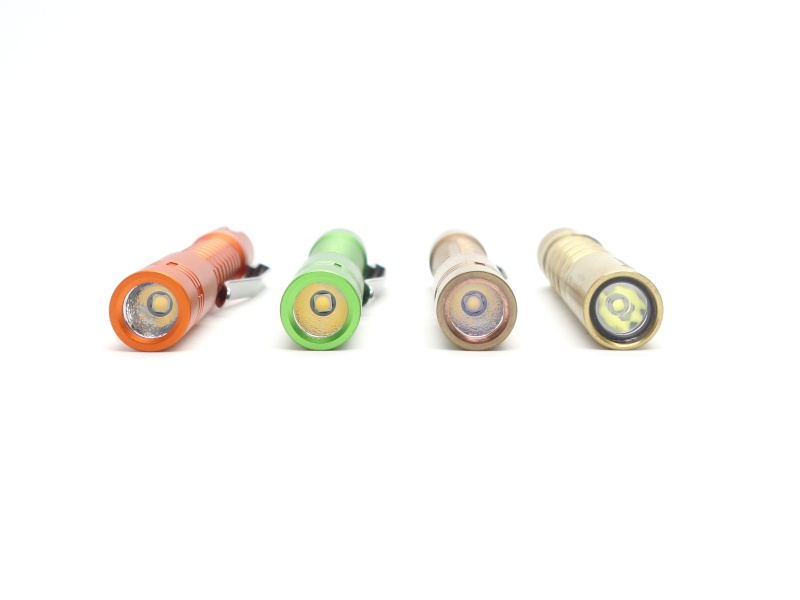
User interface#
The user interface is simple to use but it is complex to configure.
| State | Action | Result |
|---|---|---|
| Off | Click | On |
| On | Click | Off |
| On | Half click (tap) | Cycle (Moonlight, 2%, 20%, 100%) |
| On | Double half click (tap) | 100% |
Here are some of the things that can be configured:
- select one of four mode groups;
- toggle mode memory on or off;
- toggle moonlight mode on or off;
- change the cycle order (Low to High, or High to Low).
Here is a guide from Rey’s website:
Thanks Kevin Manley for the more detailed manual.
Reylight Mini Pineapple Programming Guide
1. (Full click to) Turn on the light.
2. Half click the button 8+ times. The light will now blink once, then strobe, blink twice, then strobe, blink three times, then strobe…After 5 blinks and a strobe, the sequence repeats.
a. 1 blink: mode group selection. Half click the button to enter this menu.
i. 1 blink: (ML)-2%-20%-100%
ii. 2nd blink: (ML)-10%-40%-100%
iii. 3rd blink: (ML)-2%-10%-50%
iv. 4th blink: (ML)-50%-100%-strobe-SOS
It then repeats. Half click the button during any blink to select that mode group.
b. 2 blinks: mode memory on-off toggle (default off). Half click the button during the two blinks or during the strobe after to turn mode memory on. Repeat to turn mode memory off.
c. 3 blinks: moonlight mode off-on toggle (default on). Half click the button during the three blinks or during the strobe after to turn moonlight off. Repeat to turn moonlight on.
d. 4 blinks: mode order toggle (default LMH). Half click the button during the four blinks or during the strobe after to change the mode order from Low Medium High to High Medium Low. Repeat to reverse the order.
e. 5 blinks: factory reset. Half click the button during the five blinks or during the strobe after to reset the light to factory settings.
Shortcut: quick double tap to turbo.
Strobe#
Strobe has an alternating frequency.
Low voltage protection#
There is low voltage protection.
I tested low voltage protection by connecting the driver of the torch to a bench power supply and then by lowering the voltage from 4.2V to 0V for a 10440 Li-ion cell, and from 1.5V to 0V for a Ni-MH cell.
| Cell | Mode | LVP? | Cut-off |
|---|---|---|---|
| 10440 | 2% | Yes | 3.03V |
| 10440 | 10% | Yes | 3.11V |
| 10440 | 20% | Yes | 3.08V |
| 10440 | 50% | Yes | 3.14V |
| 10440 | 100% | Yes | 3.14V |
| Ni-MH | 2% | Yes | 0.44V |
| Ni-MH | 10% | Yes | 0.64V |
| Ni-MH | 20% | Yes | 0.54V |
| Ni-MH | 50% | Yes | 0.49V |
| Ni-MH | 100% | Yes | 0.51V |
PWM#
I did not notice any visible PWM (flickering).
What I like about the UI#
- Simple to use.
What could be improved#
- A user manual with a programming guide might be helpful.
- Ni-MH 50% appears to be the same as Ni-MH 100%. This might be a bug.
Batteries and charging#
Battery#
An included flat top 10440 Li-ion 3.7V 350mAh cell arrived with a voltage of 3.68V.
A piece of card was found at the top of the cell to prevent the torch from turning on while being delivered.
I tried the following cells:
| Cell | Top | Compatible? |
|---|---|---|
| 10440 Li-ion 3.7V 350mAh | Flat | Yes |
| eneloop pro AAA Ni-MH 900mAh 1.2V | Button | Yes |
Charging#
There is no built-in charging.
I would highly recommend getting a charger like the Nitecore UMS2 or UM2 where you can manually select a charging current between 100mA and 3A.
A charging current of 100mA is much more appropriate for a 10440 cell with a capacity of 350mAh.
There are many chargers that say that they support 10440 cells but they default to 500mA or 1A. This charging current is a bit high. Ideally 350mA (1C) or less is used to prolong the cell life.
liteshop.com.au promo code: SG9IP8YKT5PI
Nitecore UMS2 at liteshop.com.au (affiliate link)
Nitecore UM2 at liteshop.com.au (affiliate link)
Performance#
Lumen measurements#
I used a bench power supply to measure the current at turn on.
| Cell | Mode | Amps at start | Lumens @turn on | Lumens @30 sec | Lumens @10 min |
|---|---|---|---|---|---|
| Ni-MH | 2% | 0.06 A | 9 | 9 | 9 |
| Ni-MH | 10% | 0.23 A | 28 | 26 | 26 |
| Ni-MH | 20% | 0.45 A | 43 | 46 | 44 |
| Ni-MH | 50% | 2.00 A | 120 | 69 | 24 |
| Ni-MH | 100% | 2.04 A | 117 | 69 | 24 |
| 10440 | 2% | 0.04 A | 14 | 12 | 12 |
| 10440 | 10% | 0.16 A | 45 | 46 | 41 |
| 10440 | 20% | 0.29 A | 84 | 82 | 75 |
| 10440 | 50% | 0.64 A | 208 | 195 | 104 |
| 10440 | 100% | 1.36 A | 371 | 339 | 105 |
The lumen output for 2% and 10% with a 10440 is slightly lower compared to the previous version of this torch.
Standby drain#
There is no standby drain. This torch has a mechanical tailswitch.
Runtime graphs#
I used my own DIY lumen tube with a TSL2591 sensor and forked bmengineer’s project RuTiTe to record runtimes.
Note: Lumen measurements may be off by 10% with my DIY lumen tube.
The room temperature was about 20 C.
Runtime#
Here is a summary of the runtime results:
| Cell | Mode | Runtime | Turn off | Final voltage |
|---|---|---|---|---|
| 10440 | 100% | 1h 8min 6s | 1h 26min 4s | 3.37 |
| 10440 | 50% | 1h 28min 0s | 1h 28min 0s | 3.37 |
| 10440 | 20% | 1h 21min 9s | 1h 21min 9s | 3.57 |
| 10440 | 10% | 2h 36min 4s | 2h 36min 4s | 3.56 |
| 10440 | 2% | 10h 40min 13s | 10h 40min 13s | 3.54 |
| Ni-MH | 100% | 3h 22min 6s | 3h 35min 24s+ | 0.81 |
| Ni-MH | 50% | 3h 29min 22s | 3h 48min 43s+ | 1.01 |
| Ni-MH | 20% | 2h 1min 48s | 2h 13min 12s+ | 0.83 |
| Ni-MH | 10% | 3h 8min 21s | 3h 14min 21s+ | 0.79 |
| Ni-MH | 2% | 11h 12min 37s | 11h 12min 37s+ | 1.08 |
“Runtime” is the time until the output reduces to 10% of the output at 30 seconds (as per the ANSI/PLATO FL1 2019 Standard).
“Turn off” is the time until my DIY lumen tube no longer detects more than one lumen. The actual time that the torch turns off may be much longer.
“+” indicates that the light remained on after recording had stopped.
The torch continued to produce less than one lumen for hours while using a Ni-MH cell. My DIY lumen tube cannot detect less than one lumen. At some point, the voltage was too low and the torch started to flicker.
Ni-MH 100% was flickering when I checked at 8 hours 25 minutes.
Ni-MH 20% was flickering when I checked at 10 hours and it continued flickering beyond 12 hours.
Ni-MH 10% started flickering at 8 hours 42 minutes.
Ni-MH 2% started flickering at 18 hours 45 minutes.
Ni-MH 50% looks very similar to Ni-MH 100%. I tested Ni-MH 50% four times. Both 50% and 100% have a current of around 2A and the lumen output is around 117 lumens at turn on. This might be a bug.
Overall, the runtime results are good for a 10440 3.7V Li-ion cell and a AAA Ni-MH cell.
Throw#
I took lux measurements with a UNI-T UT383BT at 30 seconds. 50% and 100% were measured at two metres.
| Cell | Mode | Candela measured (cd) | Distance (m) |
|---|---|---|---|
| Ni-MH | 50% | 188 | 27 |
| Ni-MH | 100% | 152 | 24 |
| 10440 | 50% | 540 | 46 |
| 10440 | 100% | 968 | 62 |
Ni-MH 100% steps down faster.
Beamshots#
I went to a local park and aimed the ReyLight Pineapple Mini at a tree 70 metres away while using 100%.
Beamshots were taken using a Sony RX100M2 using 3.2", f3.2, ISO 100, 5000K WB.
ReyLight Pineapple Mini Orange (100%)#

Acebeam Pokelit 2AA (High)#
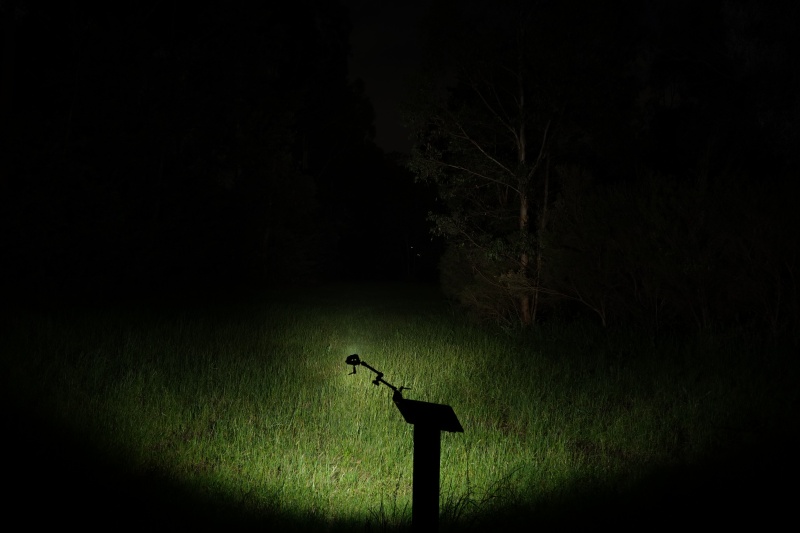
Lumintop PK27 (High 2xAAA)#

Conclusion#
The ReyLight Pineapple Mini is still my favourite EDC torch. I love the slim profile of this AAA-sized torch.
The runtime results are slightly better than previous versions of this torch.
The user interface is simple to use but difficult to configure.
I am not a big fan of the new tailcap design because the tip of my thumb needs to press inside the tailcap to push the button down. I like the feel of the old tailcap design where I can push the button more easily. That said, the new tailcap design has helped prevent the torch from turning on in my pocket.
I highly recommend getting a ReyLight Pineapple Mini! I don’t get any comission from recommending ReyLight. I am just a big fan of his torches.
Pros:#
- Excellent build quality.
- Perfect EDC size.
- Good runtimes.
- Simple UI.
- High CRI.
- Warm CCT.
- Easy to swap emitters and dedome a Nichia 519A emitter.
Cons:#
- Certain button top 10440 cells are too long.
- Ni-MH 50% appears to be the same as Ni-MH 100%. This might be a bug.
Price#
This aluminium version of the ReyLight Pineapple Mini, with an included 10440 cell, is US$35 from reylight.net.
It is a great price to get started with a ReyLight collection.
